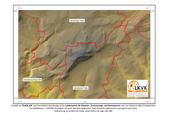Relief (geology)
For further meanings of the term see relief (disambiguation)
Under Relief ( fr. For "the Highlighted") refers to the geology and geography , the surface shape of the earth, d. H. the shape of the terrain . It arises from the effect of internal (endogenous) and external (exogenous) forces on the earth.
Endogenous forces
Forces that act from the interior of the earth (internal forces) : According to the theory of plate tectonics, the earth's crust is composed of a number of larger and smaller plates that change their position due to magma flows (convection currents) and are responsible for mountain formation , volcanism and earthquakes . Where plates meet, large mountains of folds and deep sea channels arise . Through compensatory movements, individual parts of the mountain are raised up in blocks to form clumps. Other parts, in turn, sink. This creates trenches and basins.
Exogenous powers
Forces that act on the surface of the earth from the outside (external forces): The rock formations created by endogenous forces are steadily degraded ( weathering ), removed ( erosion ) and deposited ( sedimentation ) by the exogenous forces . External forces include water , wind , ice or living beings, especially plants. Humans, too, have now become a relief-forming factor by performing large-scale terrain modeling , influencing erosion or reclaiming land .
Large landscapes - relief forms
They are the result of endogenous forces. The crust parts that protrude above the water surface are subject to the influences of exogenous forces.
- High mountains : over 2000 m, mostly rising above the snow line , they have steep and craggy shapes that are mostly of glacial origin. These are young fold mountains of the Alpidic mountain formation. They emerged during the last 100 million years and stretch from North Africa ( High Atlas ) across southern and central Europe ( Pyrenees , Alps , Carpathians , Balkans ), Southwest and South Asia ( Caucasus , Himalayas ) to Southeast Asia. Other fold mountains can be found in the circumpacific region, such as the Rocky Mountains , Andes and Japan .
- Highlands : landscapes, from an altitude of 1000 m; higher are the highlands of the Andes and Tibet .
- Plateau : flat shape with little difference in relief
- Low mountain range : up to 2000 m; often have the character of a plateau or appear as stratified landscapes.
- Mountains and hills : up to 1000 m; seldom have jagged shapes; are often threshold mountains and edge mountains ; originated in the primeval earth period ( Precambrian ) and were reshaped in the ice age .
- Table area: from 500 m; characterized by horizontal storage of the layers; inclined at the Arabic table.
- Plains and lowlands : areas with little difference in altitude. They are of sediments from the younger Mesozoic ( Mesozoic ) and from the Cenozoic ( Cenozoic covered).
- Plain : Areas with very little height difference - within the flatlands.
- Great Plain : less than 200 m; Coastal plains and river landscapes.
